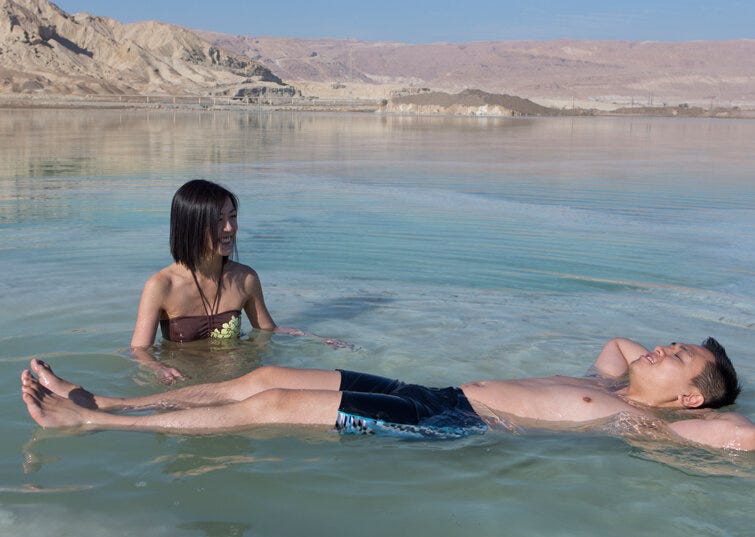
The Dead Sea, the lowest place on Earth and one of its natural wonders offers a holiday experience unmatched by any other tourist location worldwide. Though small, Israel combines side-by-side extreme opposites, such as ancient archeology alongside cutting-edge technologies, a desert landscape hiding sweet waterfalls, and wild animals revealing themselves at arm’s length. But even more so, a breathtaking mountainous desert landscape tinted in a yellowish brownish pallet containing in its center the blue lagoon bordered by its brilliant white shores that offers mystical potency for treating body and soul.
A number of streams flow through the mountains of the Judean Desert towards the Dead Sea, sweeping with them unique minerals that enrich the water with exclusive materials and properties. One can hike along any of these streams (Zeelim, Mishmar, and Dragot) during most of the year as the trails are all clearly marked [by the Society for the Reservation of Nature]. In winter one should check the weather forecast to avoid desert floods. These streams offer the desert wildlife and hikers touring the desert a true oasis.
The Dead Sea was an important historic crossroad connecting famous sites such as Masada, famous for its unique heroic story, and the Caves of Qumran where the hidden scrolls were discovered.

Extreme Attractions
Floating on the surface of the Dead Sea water has become its most famous attraction; however, you will find along the shores of the Dead Sea plenty of sports activities such as riding camels, jeep tours, biking, walking paths, or extreme mountain climbing and rappelling. Most activities can be combined with a field lunch and camping under the desert stars.
The Dead Sea
The shores of the Dead Sea offer visitors a wide choice of hotels of different grades, according to international standards. The location on the shores of the Dead Sea offers a variety of treatments and relaxation possibilities with access to thermal baths, modern tennis courts, and Dead Sea spas as well as healthy dipping in the Dead Sea, mud masks, and safer tanning due to the unique conditions of the lowest place on Earth.
Neighboring Settlements
The numerous Kibbutzim established along the Dead Sea have become a part of the local tourist attraction, often visited as unprecedented examples of Kibbutz's unique way of life and testimony to man’s ability to transform tough desert terrain into a lush, green, and lively area. Mitzpe Shalem, Almog, Kalia, Ein-Gedi, and others, are some of the most prominent Kibbutzim in the area.
Dead Sea Streams and Oases
Og Steam and Og Reservoir – is a 4 4-kilometer marked trail suitable for family hiking. The trail offers a unique experience of climbing with brackets set in the rock bed. The narrow stream is deep and mostly in shadow. Along the walking path and adjacent to the palm groves is a water reservoir (forbidden for bathing) that drains reclaimed water for the benefit of watering the agricultural fields and groves in the area.
Salvadora Steam
Nahal Salvadora intersects the road between Mitzpe Shalem and Ein-Gedi and has a walking trail of about one kilometer long. This walking path intertwines between large rocks embedded with fossils. Over the past years, the waterfall dried up however, a small spring still exists. This spring hides a huge Cistanche salsa bush (commonly known as Broomrape) that flowers in shades of pink and white during the months of March and April. The stream got its name from the Salvadora bush that grows there.
Arugot Stream, David Steam, and the Ein-Gedi Nature Reserve
A true oasis, rich in flora unique to the Judean Desert, and a source of life with sweet water springs, cool pools, dense vegetation, and a rich wildlife of Rock Hyrax, birds, and chamois so close you can almost touch them.
The trails going through the nature reserve enable families to visit both streams Nahal David and Nahal Arugot – the wildest and most beautiful of the Judea Desert streams.
The nature reserve provides a special walking path for the disabled enabling them to reach the breathtaking observation point which is only a few meters away from the lower part of Nahal David. The Ein-Gedi nature reserve is a historic gem through which we can witness the original methods of cultivating land using terraces and irrigation pools as practiced by the ancient Jewish settlements during the time of the Roman-Byzantine Empire. Other historical relics found in the area: are caves dated from the times of Bar-Kochva and burial caves of the Hashmonai family. The strong contrast between the steep, arid cliffs and the abundance of green and blue of the Dead Sea water the clear fresh air of the desert, and the sound of the waterfalls create a harmony of rare beauty contributing to the unforgettable experience of the hike.
Caves of Qumran
The first to discover the caves of the ancient Jewish settlement from the times of the second temple was a small Bedouin boy in 1947. This discovery brought scientists and archeologists from around the world to research and excavate the area which in time led to the discovery of the Dead Sea Scrolls – which tell the wonders of the time and people of Qumran. These findings made Qumran one of the most important archeological sites in Israel and the entire world.
Today one can see also the 13 Mikveh – ritual baths – that were discovered in the compound, water ducts for transporting water, and above all a wide aqueduct that transported water from the cliffs to the site (it is reasonable that there was also a spring in the area). Many artisans provided for the local population. Another site excavated nearby is Ayanot Zukim Nature Reserve, an agricultural farm where the settlers of Qumran worked. To the East of the site, an enormous cemetery was excavated with an impressive 1100 graves that reflect the extent of the population and history of the place.
Let us show you the Dead Sea >> http://www.deadsea.com/

